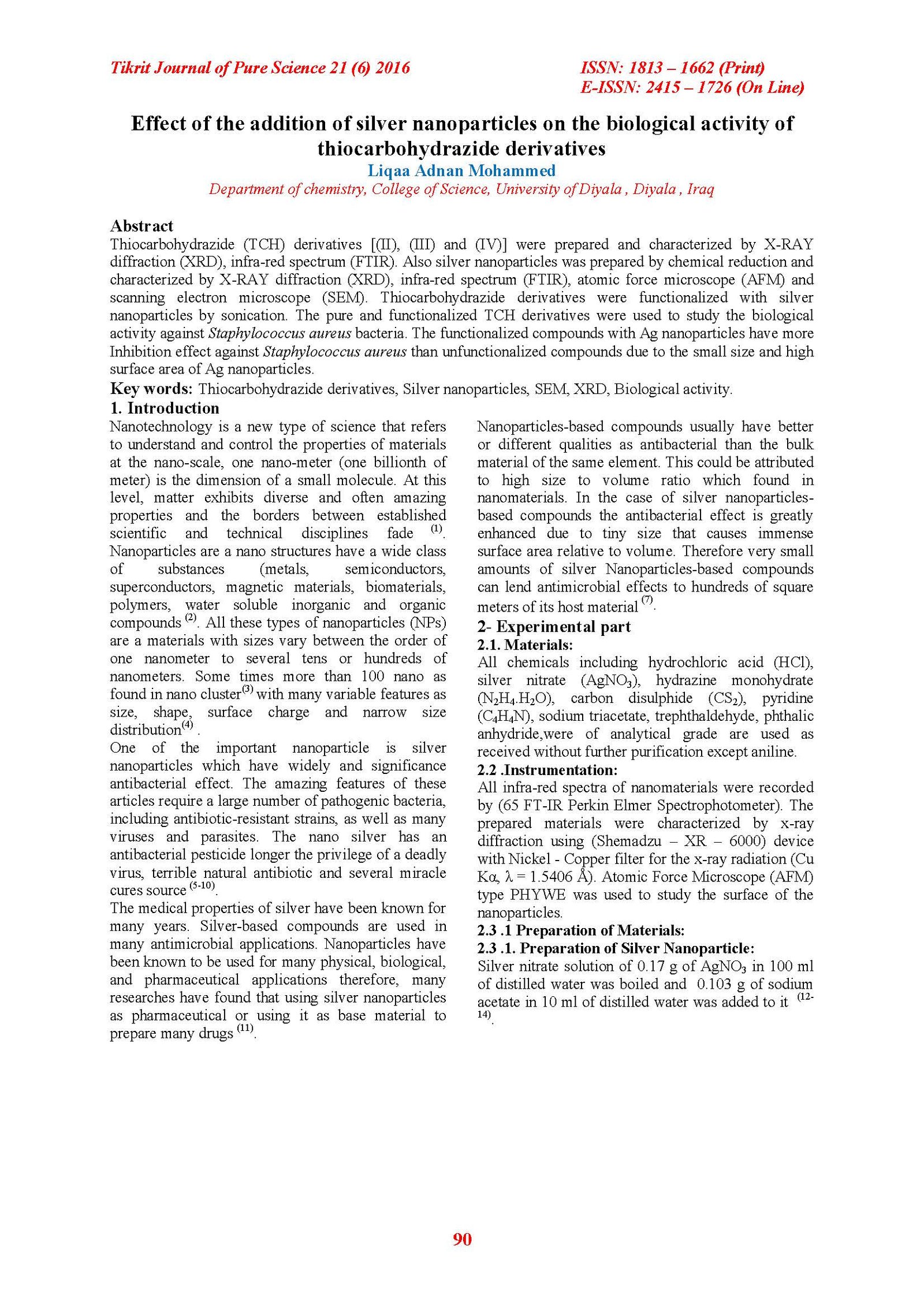Effect of the addition of silver nanoparticles on the biological activity of thiocarbohydrazide derivatives
Main Article Content
Abstract
Thiocarbohydrazide (TCH) derivatives [(II), (III) and (IV)] were prepared and characterized by X-RAY diffraction (XRD), infra-red spectrum (FTIR). Also silver nanoparticles was prepared by chemical reduction and characterized by X-RAY diffraction (XRD), infra-red spectrum (FTIR), atomic force microscope (AFM) and scanning electron microscope (SEM). Thiocarbohydrazide derivatives were functionalized with silver nanoparticles by sonication. The pure and functionalized TCH derivatives were used to study the biological activity against Staphylococcus aureus bacteria. The functionalized compounds with Ag nanoparticles have more Inhibition effect against Staphylococcus aureus than unfunctionalized compounds due to the small size and high surface area of Ag nanoparticles.
Article Details

This work is licensed under a Creative Commons Attribution 4.0 International License.
Tikrit Journal of Pure Science is licensed under the Creative Commons Attribution 4.0 International License, which allows users to copy, create extracts, abstracts, and new works from the article, alter and revise the article, and make commercial use of the article (including reuse and/or resale of the article by commercial entities), provided the user gives appropriate credit (with a link to the formal publication through the relevant DOI), provides a link to the license, indicates if changes were made, and the licensor is not represented as endorsing the use made of the work. The authors hold the copyright for their published work on the Tikrit J. Pure Sci. website, while Tikrit J. Pure Sci. is responsible for appreciate citation of their work, which is released under CC-BY-4.0, enabling the unrestricted use, distribution, and reproduction of an article in any medium, provided that the original work is properly cited.
References
1- S. Mathias, European Commission, ISBN 92-894-7498-X, P. (1-60), (2004).
2- L.T. Vincenzo, Springer Science, ISBN-13: 978-0387-26427-1, P.(1-165), (2006).
3- A. Didier, WILEY-VCH , VOL 1, ISBN: 978-3-527-31572-7 , P.(1-636), (2008).
4- G. Moorthy, S.P. Thotapalli, K.S. Muniram ,D.G. Murugan, K. Sudalyandi, S. Lonchin, Materials Research Bulletin, P.(2113–2119), (2012).
5- J.S. Kim et al., Nanomedicine: Nanotechnology, Biology, and Medicine, vol (3), P. 95–101, (2007).
6- D. Nelson, D. Marcela, B. D. J. Marcelo, B. S. Amedea, J. F.Wagner and N. Gerson, Nanomedicine: Nanotechnology, Biology, and Medicine, doi: 10.1016/j.nano.2015.11.016, P. (1-43), (2015).
7- Dhermendra K. Tiwari and J. Behari, Advances in Biological Research, 3 (3-4), P. (89-95), (2009).
8- GianluigiFranci et al., Molecules, vol(20), doi:10.3390 / molecules20058856, P. (8856-8874), (2015).
9- Sarah A. Gillig, The Ecosystems Center at the Marine Biological Laboratory, (2008).
10- I. Sondi, B. Salopek-Sondi, Journal of Colloid and Interface Science, VOL (275), P. (177–182), (2004).
11- Prabhu and Poulose, International Nano Letters, VOL(2), 32, (2012).
12- Nityananda Agasti, and N.K. Kaushik, American Journal of Nanomaterials, vol. 2, no. 1, doi: 10.12691 /ajn-2-1-2, P.(4-7), (2014).
13- Sawsan Mohamed Abu El Hassan Mosa, International Journal of Advanced Research in Chemical Science (IJARCS), Vol 1, Issue 10, , P.(38-40), (2014).
14- Ratyakshi et al., Asian J. Chem, Vol.(21), No. (10), P.(113-116), (2009).
15- M. Hakimi and P. Alimard, World Applied Programming, Vol 2, Issue 6
( 2012). 377-388.
16- A. A. Aly, A.B. Brown, T. I. El-Emary, A. M. Ewas, and M. Ramadane, ARKIVOC, (2009),150-197.
17- T.D. Xiao, P.R. Strutt, M. Benaisd, H. Chen and B.H. Keart, Nanostructured Material J., Vol.10, No. 6.1051-1061, (1998).
18- X.Wu and A.Xu, J. Mater. Chem. A, 2, 4852, (2014).
19- H. Wang et al., Colloids and Surfaces A: Physicochem. Eng. Aspects, VOL.(256), P.(111–115), (2005).
20- Ji Ha Lee, Sunwoo Kang, Jin Yong Lee and Jong Hwa Jung, Soft Matter, VOL. (8), 6557, (2012).
21- S. Kittler, C. Greulich, M. Ko¨ ller and M. Epple, Mat.-wiss. u. Werkstofftech., VOL. (40), No. 4, (2009).
22- Cardoso et al., Journal of Nanobiotechnology, VOL(12), 36, (2014).
23- Bin Ahmad et al.,Chemistry Central Journal, VOL.(6), 101, (2012).
24- Ashraf A. Mostafa et al., Hindawi Publishing Corporation Journal of Nanomaterials, http://dx.doi.org/10.1155/2015/789178, Article ID 789178, (2015).
25- D. L.Virginia, F. D. O. Luciane, D. A. G. Kaliandra, K. Jörg and B. C. Mateus, Journal of Materials Chemistry, VOL.(21), 12267, (2011).
